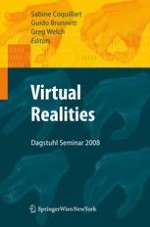2011 | OriginalPaper | Buchkapitel
6. Action Capture: A VR-Based Method for Character Animation
verfasst von : Bernhard Jung, Heni Ben Amor, Guido Heumer, Arnd Vitzthum
Erschienen in: Virtual Realities
Verlag: Springer Vienna
Aktivieren Sie unsere intelligente Suche, um passende Fachinhalte oder Patente zu finden.
Wählen Sie Textabschnitte aus um mit Künstlicher Intelligenz passenden Patente zu finden. powered by
Markieren Sie Textabschnitte, um KI-gestützt weitere passende Inhalte zu finden. powered by
